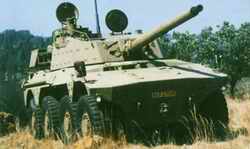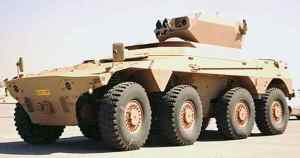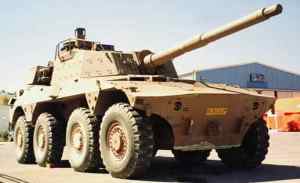| Designation: | Rooikat 76 |
 |
|---|---|---|
| Manufacturer: | Reumech OMC | |
| Product type: | Armoured Vehicles | |
| Name: | Reconnaissance Vehicle |
The Rooikat 76 Armoured Fighting Vehicle, with a 76 mm gun, was developed by Reemit for the South African National Defence Force (SANDF) and has been in operational use with the SANDF since 1980. In 1990 an upgrade and redesign programme was started by Reumech OMC (now Vickers OMC) to customise the Rooikat for the international market, and by 1994 the development of the Rooikat 105 variant with a 105 mm rifled gun was completed. The Vickers OMC Rooikat 105 is designed for high mobility day and night-time combat operations. Passive image intensifiers and thermal imaging equipment for night driving, navigation and weapon deployment permit round-the-clock combat operations.
The main role of the Rooikat 105 is combat reconnaissance with seek and destroy missions. The Rooikat has the fire power and survivability to engage in battle against selected targets. The secondary role of the Rooikat 105 is in combat support operations. In anti-armour operations the Rooikat performs a valuable role in protection against enemy armoured threats.
The Rooikat carries a crew of four, commander, gunner, ammunition loader and driver.
Development of the Rooikat armoured car commenced in 1976 when three 8x8 vehicles were built to verify platform concepts. This was followed by a further three vehicles which were built and evaluated by the South African Defence Force in the early 1980s.
These experimental development models (XDMs) consisted of (6 x 6) 22 tonne 76 mm, (8 x 8) 24 tonne 76 mm and (8 x 8) 32 tonne 105 mm armed concepts. The Rooikat was eventually developed from the (8 x 8) 24 ton 76 mm concept.
Full-scale development commenced in late 1985 with the vehicle first being unveiled in October 1988 as the Rooikat.
Five Advanced Development Models (ADMs) were completed in 1986/87 for extensive operational and technical evaluation trials. In 1987, work started on building four Engineering Development Models (EDMs) for user evaluation trials and also to confirm modifications that resulted from the troop trials with the Advanced Development Models.
First Rooikat vehicles were completed in 1989 with the vehicle becoming operational with the then South African Defence Force in 1990.
Reumech OMC is responsible for integration of the weapon platform and the turret, and is also the prime contractor for the system which includes responsibility for the international marketing of the system. The turret is supplied by LIW.
The main role of Rooikat is combat reconnaissance during high-mobility operations using its speed to outmanoeuvre the enemy and strike at his flanks and deep in his rear areas. Its secondary role is that of hunter/killer against a variety of battlefield targets including AFVs, with its third role being interdiction.
By 1998, total production of the Rooikat 76 mm armoured car for the South African National Army amounted to 200 vehicles with production continuing and by the end of the century a total of 240 systems will be delivered and in service.
By early 1999 there were no export sales of the 76 mm Rooikat and marketing was being concentrated on the 105 mm version covered in the previous entry.
The hull of the Rooikat is of all-welded steel armour construction with the driver seated at the front, three-man power-operated turret in the centre and the power pack at the rear.
Over the frontal arc protection is provided against penetration from the 23 mm AP (Armour-Piercing) rounds fired from the Russian ZU-23 LAAG, widely deployed in both ground and air defence roles in Southern Africa. Trials have demonstrated that the hull design of the Rooikat provides a high degree of protection against anti-tank mines.
The driver, seated on the centreline of the vehicle, can enter through the fighting compartment or through the single-piece hatch cover that opens to the left. The driver's station (including the essential controls such as foot pedals, steering wheel and direction indicators) is fully adjustable and, when driving in the closed-down position, forward observation is via three periscopes, the centre one of which can be replaced by a passive night periscope. When closed-down the driver's periscopes can be cleaned by a compressed air cleaning system. The headlamps are under armour protection at the front of the vehicle.
A hull escape hatch is provided in each side of the hull, between the second and third axles, thus avoiding the crew being exposed to small arms fire if they were to evacuate.
The commander is seated on the right of the turret with the gunnerforward and below his position, and the loader on the left.
The commander is provided with eight vision blocks to give observation through 360°. Mounted in the roof, forward of the commander's station, is a day panoramic sight with a magnification of x 12. This enables the commander to observe through a full 360° without moving his/her head. The sight can also be slaved to the 76 mm gun or uncoupled.
The loader has a single-piece hatch cover that opens to the rear, and is provided with two periscopes. These can be traversed to allow observation of the terrain on the left side of the vehicle.
The gunner has a roof-mounted periscopic sight which has x8 day and night (image intensification) channels and an integral laser range-finder. The gunner also has an auxiliary sight as used in the Ratel 90 vehicle. If required, the commander of the Rooikat can override the gunner.
Turret traverse and weapon elevation features solid-state electric controls for both gunner and commander, with manual emergency back-up. Traverse is through a full 360° with elevation limits from -10 to +20°. The commander has a single control handle and the gunner twin control handles.
The digital fire-control system receives information from a laser range-finder and a number of sensors including cant and windspeed. Ammunition type is set manually. The Rooikat can engage and hit targets with a high probability while it is moving across rough terrain.
Ballistic offsets are automatically computed and implemented when the laser range-finder is triggered, to compensate for various factors affecting the ammunition ballistics. The offsets are implemented both in the sight (electronics sight slaving) and the main weapon (auto lay) and a ready to fire indication appears in the gunner's field advising him/her to fire. Total reaction time from lasing to firing is typically less than 2 seconds.
The fire-control system provides automatic fire control by computing and implementing the ballistic offsets for the ammunition type selection by taking into account target range (automatic from laser range-finder), target speed (automatically derived by tracking the target), manually entered environmental data (air pressure, ambient temperature, ammunition temperature, headwind), crosswind speed (automatically sensed), weapon tilt (cant automatically sensed), and gun jump characteristics of the main weapon.
The fire-control system has BITE (Built-in Test Equipment) which enables any faults to be immediately traced and rectified through the substitution of line-replaceable units.
Main armament comprises a 76 mm/62 calibre gun which was developed at LIW and has the same chamber volume as the Italian Otobreda 76 mm Compact naval gun but fires different ammunition in keeping with its role. The ammunition of the naval gun can also be fired by replacing the percussion primer with an electric primer. The 76 mm GT4 gun was chosen for the Rooikat for a number of other reasons including the larger number of rounds capable of being carried when compared to a 105 mm gun, the ease of handling ammunition when moving across country and the optimum selection of recoil forces and firing impulses for maximum crew operational effectiveness.
The 76 mm stabilised gun has a vertical sliding semiautomatic breech block and is fitted with a thermal sleeve and concentric glass fibre fume extractor. The recoil system consists of a concentric hydrospring with an external replenisher with maximum recoil being 370 mm.
Two types of fixed 76 mm ammunition have been developed, HE-T (High Explosive-Tracer) and APFSDS-T (Armour-Piercing Fin-Stabilised Discarding Sabot-Tracer) with a total of 48 rounds of ammunition being carried, nine of which are for ready use, stowed vertically below the turret ring on the leftside. For safety reasons no main gun ammunition is stowed above the turret ring.
Rate of fire is stated to be 6 rds/min, with the APFSDS-T projectile having an effective range of 2.000 to 3,000 m. It will penetrate the T-54/T-55 and T-62 from all angles of attack. The HE-T round has a maximum range of 12,000 m in the indirect fire role and 3,000 m in the direct fire role. A range drum is fitted as standard.
The APFSDS-T round has a tungsten alloy penetrator with the sabot, fins and nose shield made of aluminium and the rotating obturator of Nylon 66.
The HE-T round contains 0.6 kg of RDX/TNT on a 60/40 basis with the tracer being visible for 8 to 11 seconds. The projectile is fitted with a Point Detonating (PD) and selectable delay fuze which provides a super-quick characteristic of 170 us or a delay action of between 30 and 80 us, depending on the tactical situation. A canister and practice round are under development.
A 7.62-mm coaxial machine gun is mounted to the left of the main armament, while a similar weapon is mounted at the commander's position for use in the ground and air defence roles. This is skate mounted so that it can be moved around the commander's hatch. An ammunition resupply hatch is provided in the left side of the turret.
Mounted either side of the turret rear is a bank of four forward-firing electrically operated 81 mm smoke grenade dischargers. The Rooikat can also lay its own smoke screen by injecting diesel fuel into the exhaust outlet at the rear of the hull on the left side.
Its 563 hp (420 kW) is provided by a V-10 turbo-charged water-cooled engine through a six-speed fully automatic transmission, drop down gearbox and high/ low-range transfer gearbox.
The engine, transmission, drop down gearbox and cooling system are packaged into a power pack unit which has been designed so that field exchange will be possible within 60 minutes.
The engine compartment is fitted with an automatic fire detection and suppression system.
|
||||||||||||||||||||||||||||||||||||||||||||||||||||||||||||||||||||||
|
|||||||||||||||
|
||||||||||||
 |
 |
 |
 |
 |

